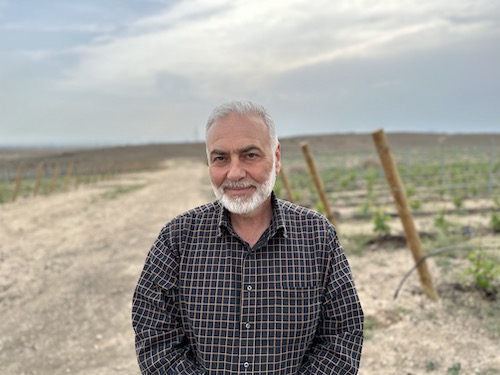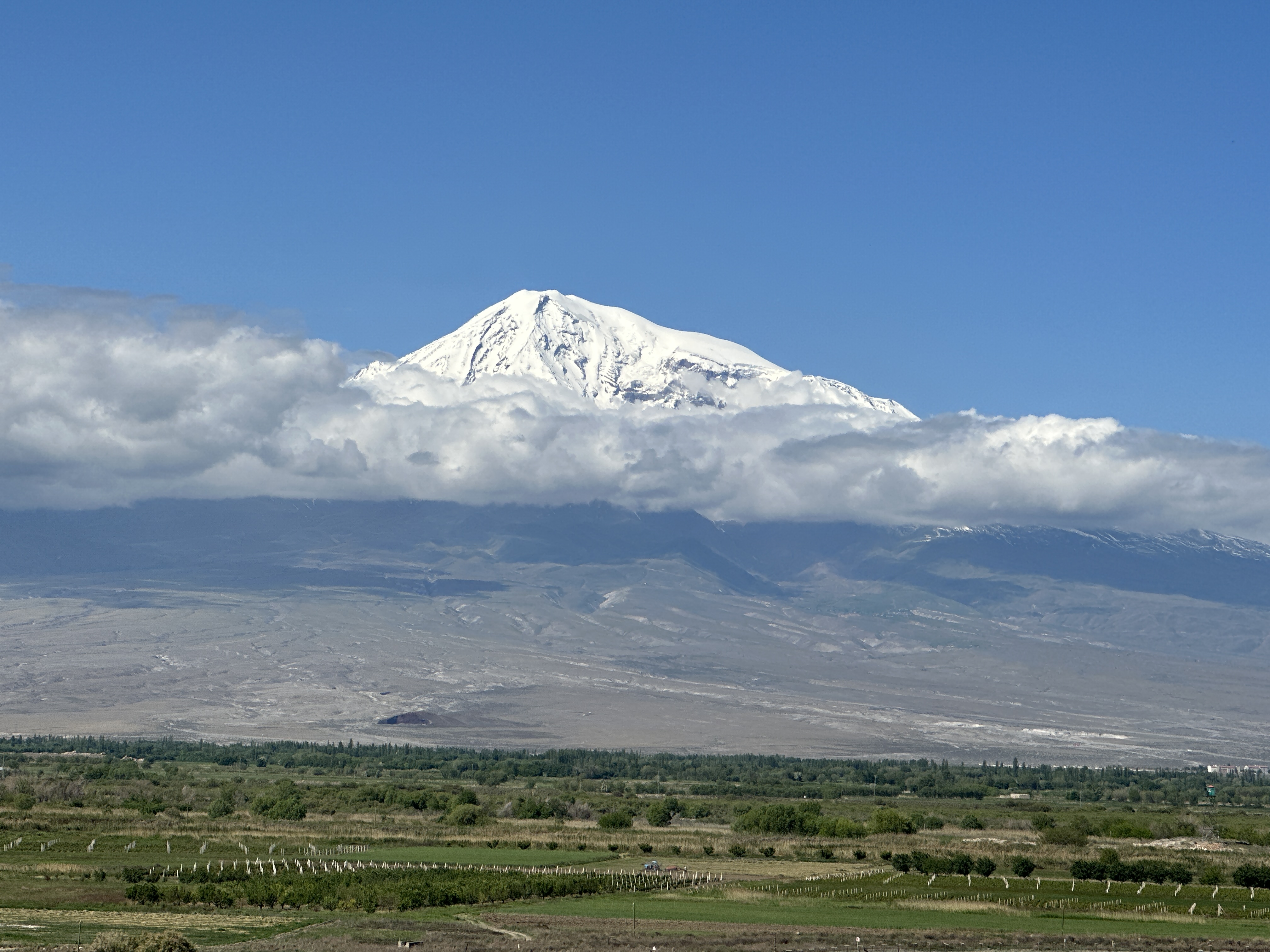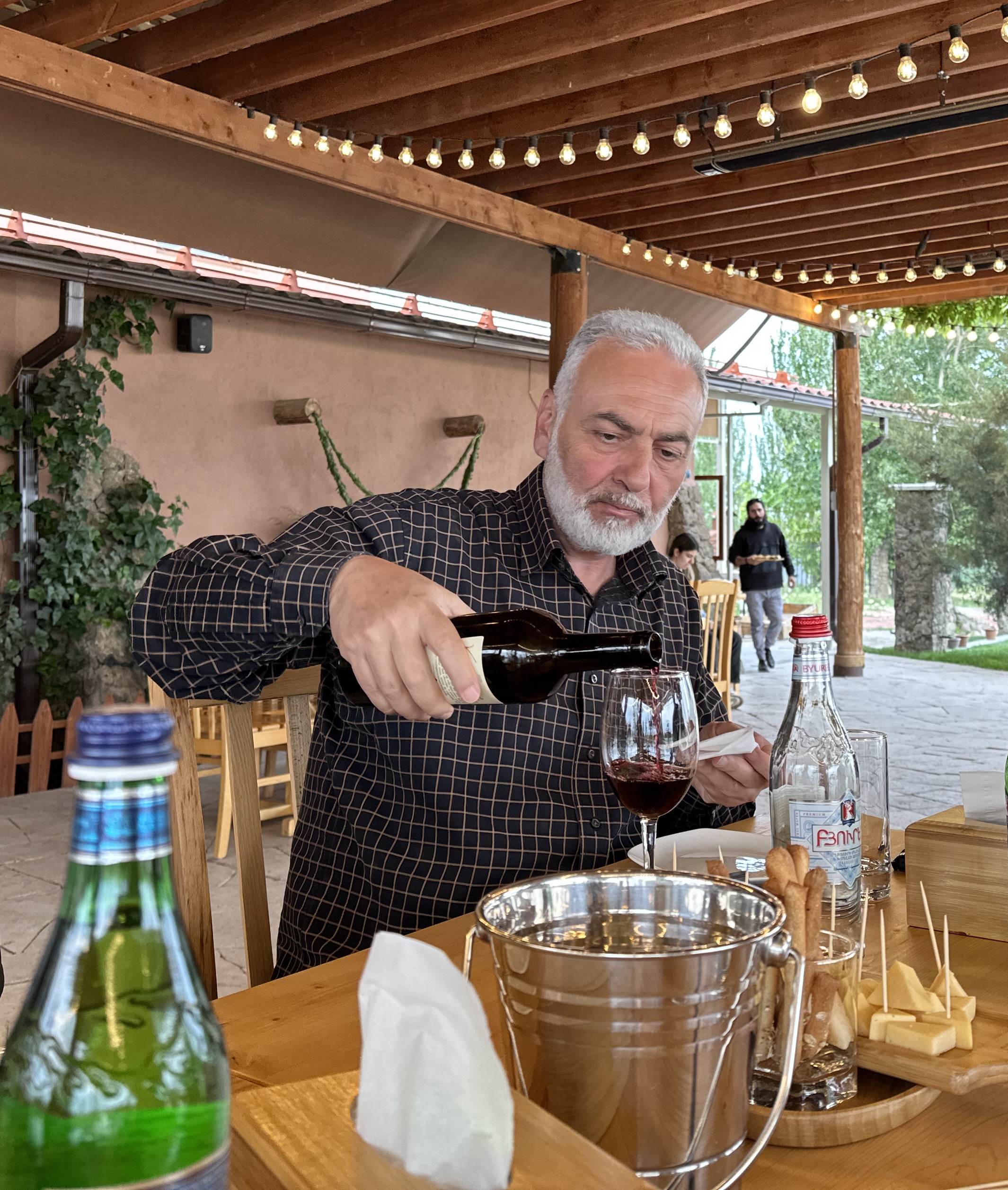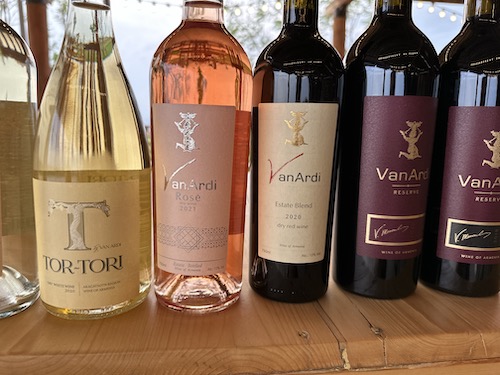Nestled in the picturesque Aragatsotn region of Armenia lies Van Ardi Winery, one of the pioneering wineries behind the renaissance in Armenian wine. With a winemaking tradition that dates back millennia, Armenia stands as one of the oldest wine-producing regions in the world.
Founded in 2012 by the Armenian family of Varuzhan Mouradian, the winery takes its name from the ancient settlement of Van Ardi, located nearby. Embracing their roots, the Mouradian family sought to pay homage to their ancestors by revitalizing the ancient vineyards that once thrived in the region. Today, the winery spans over 45 hectares of vineyards.
The Aragatsotn region of Armenia, with its high-altitude plateau and volcanic soil, boasts an ideal terroir for grape cultivation. The vineyards' exposure to abundant sunlight combined with cool nights create a perfect environment for slow and balanced ripening, resulting in grapes with intense flavors and elegant acidity. The distinct microclimate of the region infuses the wines with a sense of place.
Van Ardi Winery is devoted to crafting wines that are a true reflection of Armenia's vinicultural heritage. Among their flagship offerings is wine from the indigenous Areni Noir grape. This red wine exudes an aroma of ripe red fruits and spices, leading to a velvety palate with a balanced structure. Another highlight is Voskehat, an indigenous white grape, with notes of citrus, apricot, and floral undertones.
Van Ardi Winery is deeply committed to sustainability and social responsibility. The vineyards are managed with organic, environmentally friendly practices, promoting biodiversity and preserving the natural ecosystem.
Jason Borrows: So tell us a little bit about how you ended up in Armenia making wine.
 Varuzhan Mouradian: I'm going to start from the beginning. Wine was always my passion. It started when I was a successful CPA. I had a CPA firm in California, and then I thought, I'm not going to spend the rest of my days in the office environment.
Varuzhan Mouradian: I'm going to start from the beginning. Wine was always my passion. It started when I was a successful CPA. I had a CPA firm in California, and then I thought, I'm not going to spend the rest of my days in the office environment.
And I thought that I need something creative and something close to nature and wine was it. I decided that wine will be my future. And the question arose whether to do it in California or Armenia. Discussing all these things with my family we came to the conclusion that it has to be Armenia, because Armenia has this old historical wine culture that we need to revive.
And my accounting background helped me a lot to plan this very thoroughly and finally, in 2008, we have planted our first vineyards and everything started from there.
One of the things that's very interesting about Armenian wine is you have these two separate origin stories, this mythological origin story, which is, you know, Noah landing on Mt. Ararat, coming down, growing grapes, making the first wine, and then you have this more scientific origin story, which is the one that gave the DNA analysis of, first winery, the Areni-1 cave.
Sure. There was the mythology, the history about Noah planting his first vine here and all the history of the cave one, also the story of the Van Kingdom that was fascinating to me because Van Kingdom, about 2,500 years ago was kind of like the Bordeaux of the antique world. And there were all these historical accounts telling that neighboring countries like Babylon and Assyria, were taking this beautiful wine out of this country.
I always ask this question: How come that then, Armenia was kind of center of the winemaking, and now the world doesn't know about Armenian wine? Because the soil is the same, the sun is the same, same everything. The terroir is the same. So it was just that at that period of the Ottoman Empire and then the Soviet Empire that destroyed the wine culture of Armenia.
And then everything is the same. When you now come and try our first wines, we are making really our first wines even now, I think that we didn't make our best wines. We didn't even scratch the top of the iceberg with our potential. These soils, the foothills of foothills that we are in, are actually brilliant soils for the wine, wine grapes because they are rocky, there are a lot of minerals, different types of stones.
Within this small terroir you can find different three or four types of mineral stones. And that gives a diversity with all these minerals and every component that comes to the grape and then to the wine.
I'd like to get a sense of what you think the culture was like during the Soviet times.
 What essentially happened to Armenia during the Soviet times that influenced the drinking culture of the country is that during the Soviet times it was planned that one country will make brandy and one country will make wine. And Armenia was selected to be a brandy maker.
What essentially happened to Armenia during the Soviet times that influenced the drinking culture of the country is that during the Soviet times it was planned that one country will make brandy and one country will make wine. And Armenia was selected to be a brandy maker.
However, the winemaking was not completely gone from Armenia. Here and there in some villages, for their own families, people were making wine and pretty good wine. I was born in Soviet times and my student years were spent here so I remember tasting those wines going on in villages and tasting all these homemade wines.
And that was part of my passion towards wine. So, yes, we did have some old ways of winemaking in Armenia and I had that in me. And plus the years that I spent in California visiting all the beautiful Napa Valley and, you know, Santa Barbara, Santa Ynez, all these regions, I was thinking, "Why can't we have these beautiful vineyards in our country?" And, the answer was, "Who said we we can't? Yes, we we can!" We just needed an approach. We can just have the will to do it. Little finances and water just to grow with the vine.
And talk a little bit about the transition from a Soviet model to Armenia becoming an independent country and how the wine industry kind of revived itself or recreated itself.
Well, we are talking a lot now about the Soviet times. Even during the Soviet times we had some type of winemaking existing here.
However, the world has gone further, experienced and developed their winemaking styles. And here the Soviet type of winemaking was kind of mass production. There was no soul in the wine. After the Soviet Union collapsed, during the independence years a couple of people came from outside, you know repatriates with their wine experience, and they put this new level for everybody.
So these people came in and starting to make small wineries, and they were getting all these gold medals from the international competitions. And then the people here say, "How come we cannot do this?" And by looking to us, they invested in their production lines. And now we have this development going throughout Armenia now, which is a pretty good thing. And now I'm very, very positive that it is just matter of time until the wine world recognizes Armenia as being one of the good winemaking nations in the world.
You've spent a lot of time in California. How do the indigenous varietals that you found here kind of compare with some of the great grapes on the world stage?
 The world is making a lot of good wines. There's no question about it. This question I get asked to me every time - how would you compare Armenian wines? I cannot compare in any way because the grape varieties are different.
The world is making a lot of good wines. There's no question about it. This question I get asked to me every time - how would you compare Armenian wines? I cannot compare in any way because the grape varieties are different.
The grapes are great, I understand that, but they are different. Our approach to winemaking is a little different than a classic one I would say. We know that wine is being evaluated based on three components: eyes, nose and texture. However, we believe that there is another character of the wine, and there would be some others that science didn't research enough. By drinking the first sip, you need to understand from the bud breaking, what type of winds, what type of rains they feel, how that has converted into the wines.
The energy surrounding the vines and the wine. The wine is absorbing all this information and able to transfer this information to the consumer. So the consumer needs to feel all this character of the wine. And that's why the energy is so crucial for our estate, vineyards, people that we work with here, the songs that we put on them. It's physics to me, just simple physics. Vibrations make a difference in the structures, this way or the other way. And I believe it is doing it in a good way. So I think the energy is one of the main things that our Armenian wine has that is a little different than other wines.
And what is your philosophy of winemaking and viticulture?
One of the big components of the terroir. The meaning of the terroir definitely is the philosophy of the winemaker besides the soil and sun. Let's see. Our philosophy, our approach to the viticulture in enology is just to create the right environment for the grapes in the first place. To feel good, to give their best to the winemaker and after that, getting the best possible grapes from the terroir.
Then the job of the winemaker is be as less invasive as he can be. Just try to again create the good place in the cellar for the grapes to transform to the wine and to tell about the terroir. So less invasive. That's the number one rule for us. To let the grapes talk themselves.
When we planted our first vineyard we didn't add any poison to the soil, to the grass and the vines, anyhow. I have learned that there is this organic program. I said, "Why not do it?" Because we are doing it the same way, you know. Anyway, so we did apply for organic certification and now our estate vineyards are certified organic. Besides that, we are also using these bio-natural approaches, which are, you know, sound, vibration and other good approaches. Actually, in Armenia it is easier and cheaper to do organic than otherwise because nature is here and nature is helping us actually.
The other thing we did, we did a lot of research in the manuscript. We did find a couple of recipes of how to, you know, fight the diseases. And we have a lot less disease or one or two diseases for the grapes, a fungus type of disease. And we use all natural components like eggshells.
And you are using sound in the vineyard or in the cellar?
 Yes, using sound in the vineyard and cellar are different. In the vineyard we use not a lot of Bach, but a lot of Armenian liturgy, music. And in the cellar, the music has to be more harmonic because wine needs to balance the notes and they have to follow each other in a little more harmonious way.
Yes, using sound in the vineyard and cellar are different. In the vineyard we use not a lot of Bach, but a lot of Armenian liturgy, music. And in the cellar, the music has to be more harmonic because wine needs to balance the notes and they have to follow each other in a little more harmonious way.
I have three music zones, actually. And the other zone is for the workers to hear more funny music that can cheer them up so they can give their good energy to the grapes that they are working with. Yeah, this is a lot. It's fantastic.
And so one thing that I think is very interesting about the Armenian wine story, the modern Armenian wine stories, is that you have quite a few people like yourself.
People use the word diaspora. I just prefer not to use that because I think it's a kind of complicated word that many people don't understand. And I would rather say people who have returned to their homelands, you know, people who have come back and have helped reinvigorate this industry, have helped give it life. And it's bringing back something from the past and and bringing it to the future.
Why do you think that's happened? And maybe just talk a little bit about this movement of people back towards Armenia.
When I moved to the US, actually, I heard the words "emigration lawyer" for the first time because a lot of people were going to the US at that time and in Armenia or in any other country that I have been, nobody knew that term.
And now in recent years, I found that a lot of law firms here are specializing in emigration. That means we are having emigrants coming in and Armenians that wanted to come to their homeland leave and create here. That's pretty normal because a lot of people here are saying while everybody is going to the US, you are coming back from the US, so this is something special.
I'm saying, no, this is normal. It is normal. It's nothing extraordinary that people should come and work in their homeland, create culture. And that's what we want to do. We want to create a culture of winemaking families. All of my children were born in the US, my four children, and all of them are here now with me, helping me to create this culture of winemaking families.
And I guess I will enjoy this creation process. I'll be the grandpa of this family and they'll put my picture somewhere here. And that's that. That will be very satisfying for me. And, later, my future generations will realize the financial part of the wineries. So that's how the world is designed.
Talk a little bit about some of the grapes that you're working with right now.
 Right now we are working with mainly Armenian grapes— Areni, Haghtanak, Voskehat and Kangun. With international varieties I only work with Syrah because as a consumer, I love Syrah. And I thought that that's going to be just thriving on the Armenian soil.
Right now we are working with mainly Armenian grapes— Areni, Haghtanak, Voskehat and Kangun. With international varieties I only work with Syrah because as a consumer, I love Syrah. And I thought that that's going to be just thriving on the Armenian soil.
Other than that, yes, we do have a lot of other Armenian grapes that we need to work, and now I'm doing a lot of work with forgotten varieties that are not available in a commercial way. So from this village or that old, old vineyard, we are finding this and doing some minor vinification and trying to see how we can work with them.
So that's why I'm saying this is just the beginning. We have a lot of work to do for the Armenian winemaking and not only with one generations, we have years to come.
And what are your hopes for the future of wine in Armenia?
I'm always a positive person. I'm looking forward to having a fantastic future for Armenian wines because we have all the components to create the type of wine that the world consumers are looking for.
We do have the wines, we do have something to show them. Our main problem is the awareness. People need to know about the Armenian wine. And from the first sip they are just starting to like it and kind of surprised and say, "How come they they didn't know about Armenian wines before?"










